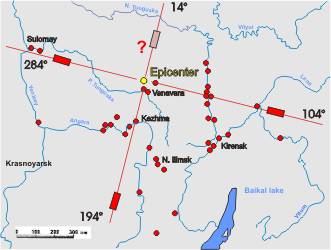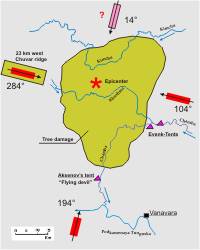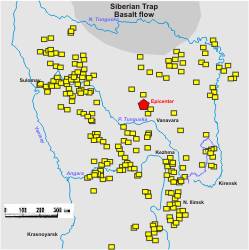|
The Tunguska phenomenon of 1908 in Siberia
An electric discharge between the earth surface and a hot plasma ?
- A suggestion for professionals -
Norbert Brügge, Germany
Dipl.Geol.
mailto: [email protected]
The Tunguska event was a large
explosion that occurred near the Podkamennaya Tunguska river in Yeniseysk
Governorate (now Krasnoyarsk Krai) in Siberia, on the morning of June 30,
1908. The explosion over the sparsely populated Eastern Siberian Taiga flattened
an estimated 60 million trees over an area of 2,000 km2 of forest.
Around 7:00 a.m., a glowing object appeared
in the clear summer sky, the shape of which was similar to a cylinder or a
beam and whose brightness was compared with the sun. According to eyewitnesses,
the object appeared at the level of the low sun in the east. The brilliantly
bright object poisy across the sky and disappeared on the western horizon.
At the point where the object had disappeared, the sky lit up and there a
high cloud of smoke appeared. After that, strange detonations could be heard
and the earth shook far from the explosion site. A bright glow of fire, a
strong shock, a pressure wave and thunder noises were perceived even at a
great distance.
Locals saw this "second sun" relatively
close to the explosion site. After violent explosions, earthquakes and hot
squalls were registered. Further observations suggest that at least two other
objects coming from the south and west led to explosions, which lasted about
an hour with breaks.
The seismographs registered the tremors in all meteorological stations in
Europe and North America. During the strangely bright nights that followed,
silver shining clouds of an extraordinary sheen appeared over Eastern and
Western Europe.
Since Leonid Kulik's expedition
in 1930, which was the first to document the enormous damage in the taiga,
there have been several other expeditions to investigate the cause of the
explosions. To date, however, there is no useful scientific information. Neither
craters nor remains of meteoric material were found. All previous attempts
to design a scenario of the event are for the trash, or at least questionable.
Based on the dramatic reports of eyewitnesses, we only know that glistening
bright "objects" passing the atmosphere dissolved completely in strange explosions
near the earth's surface and that there was a bright night in the wider area
before the event.
|
Only the proposed theory to the origin
of the Tunguska event by Dr.-Phys. Andrei Ol'khovskaya is worth to discussing.
"Tunguska event of 1908 was to be of geophysical origin !"
http://tunguska.eu5.org/tunguska.htm
Comment:
Even though I am skeptical of his theory as a geologist, he has thankfully
collected a lot of facts that are worth studying and from which I have
ultimately benefited.
|
An electric discharge
between the earth surface and a hot plasma
From the sum of the observations
I derive my theory that the Tunguska event was the explosions of "hot" plasma.
It probably originates from the boundary layer between the ionosphere and
the plasmasphere of the earth and was transported along lines of the magnetic
field to a strongly positively charged hotspot on the earth's surface (Tunguska
region), where explosive discharges took place.
The plasmasphere is the inner, to a torus closed part in the terrestrial magnetosphere
and is filled with a relatively dense and cold plasma. It consists of ionized
atomic nuclei (ions) with a critical mass of released electrons and is fed
from the ionosphere. It is electrically conductive, but is in energetic equilibrium.
Recent satellite observations have shown that irregularities in density in
the form of clouds or imperfections can form in the plasmasphere. New observations
have also shown that the plasma could be in principle arranged like a tube
along the field lines of the magnetic field.
The "cold" plasma can become the "hot" plasma if significantly more energy
is supplied. The energetic equilibrium is considerably disturbed by more electrons
released from the already ionized atomic nuclei (ions). The ionization increases.
This plasma lights up when free electrons are captured again by the ions,
releasing the previoisly absorbed energy in the form of light.
The scenario of
the Tunguska event could be described as follows:
In the bright nights (perceived above the taiga before
the event), a plume of cold plasma in the lower plasma sphere at the border
to the ionosphere rapidly became negatively charged. The observed light phenomena
document energetic interactions within the plasma. A plume of strongly negatively
charged plasma along magnetic field lines reached an equally strongly positively
charged (magnetic*)
hotspot in Siberia on June 30, 1908. Due to the objects arriving from four
(?) points of the compass (turned by 90�) combined with violent explosions,
it can be assumed that the plasma was split up ("tubes") and reached this
strongly positively charged part in the Tunguska region at various times.
The apparently "flat" trajectories of the objects can be explained by the
fact that there has been a diversion towards the positive hotspot.
*
Note: The Tunguska explosion is located on the southern edge
of the Siberian Trapp with an exceptional accumulation of
magnetite-diatrems (Fig. 4).
The explosions can be described
as electric discharges,
comparable to the mechanism the "Townsend
Avalanche", in which there is an avalanche-like
reaction between "hot" plasma and a positively charged hotspot. A multitude
of repetitive noises such as popping, knocking and rattling could indicate
the decaying electrical discharges.
An object that came with a roar from the east was perceived
as a beam or tube. The statement that a "devil with two eyes" came from the
south (?) could be a sighting of two tubes. Statements about a divided sky
also suggest tubes.
The bright night sky, which was still be seen over Europe for days, is an
indication of the spread of other charged plasma, which however, as in the
case of Tunguska, did not reach the earth's surface. The insignificant column
of smoke above the Tunguska cannot be the cause of the glow.
Remarkable, in Irkutsk (almost 950 km away from the Tunguska epicenter) a
geomagnetic disturbance was registered which lasted for several hours.
In order to give weight to this theory, however, the cause of the
energy supply in the case of plasma in the plasmasphere should be clarified,
as well as the fact that the plasma leaves the plasmasphere and passed the
ionosphere und finally reaches the earth's surface along magnetic field lines.
Townsend Avalanche
The avalanche occurs in a gaseous medium that can be ionised (Plasma).
The electric field and the mean free path of the electron must allow free
electrons to acquire an energy level (velocity) that can cause impact
ionisation.
The electric field is applied across a gaseous medium; initial ions are
created with ionising radiation (for example, cosmic rays). An original
ionisation event produces an ion pair; the positive ion accelerates towards
the cathode while the free electron accelerates towards the anode. If
the electric field is strong enough, the free electron can gain sufficient
velocity (energy) to liberate another electron when it next collides with
a molecule. The two free electrons then travel towards the anode and gain
sufficient energy from the electric field to cause further impact ionisations,
and so on. This process is effectively a chain reaction that generates
free electrons. Initially, the number of collisions grows exponentially. |
In order to approach the problem of the "Tunguska phenomenon",
the numerous reports by eyewitnesses are invaluable. Many sources and quotations
have been collected on Andrei Ol'khovatov's website:
Eyewitnesses accounts
|

|

|

|

|
|
Fig.1 Applied Townsend Avalanche
|
Fig.2 Map with sightings and
the obviously arranged object trajectories
|
Fig. 3
Detailed map of
the epicenter
|
Fig. 4 Magnetite diatrems
|
Eastern
Object
(azimuth 104 �)
and/or the others
A certain Semonov was at the Vanavara trading post (about 40 kilometers
south of the explosion) and suddenly saw that directly to the north, the sky
was split in two and fire appeared high and far above the forest. The split
in the sky widened and the entire northern horizon was covered with fire.
Heat came from the north. Then the sky closed and a strong thump sounded and
he was thrown a few meters. Then came a sound like stones falling or cannons
shooting, the earth shook. As the sky opened, a hot wind raced between the
houses.
The Evenk brothers Chekaren and Chunchanka reported: We slept in
our tent. We suddenly woke up. Somebody pushed us. We heard whistling and
felt a strong wind. We couldn't see what was going on outside in the tent.
Suddenly I was pushed again, this time so hard that I fell into the fire.
There was noise behind the tent, we could hear trees falling. We wanted out,
but then the thunder struck. This was the first thunder. The earth began to
move and rock, the wind overturned our tent. Then I saw trees fall and branches
burn, it grew mighty light, as if there was a second sun. And immediately
there was a loud clap of thunder. This was the second thunder. Our sun was
shining brightly as always and suddenly another one came. Then we saw that
in another place there was another lightning and loud thunder came. This was
the third clap of thunder. The wind came again, knocked us off our feet. Suddenly
we saw another lightning bolt, followed by another thunder. But the noise
was less than before. This was the fourth thunder. I can still remember there
was another clap of thunder, but it was quieter and somewhere far to the west.
Newspaper "Sibir", July 2, 1908: On the morning of June 30,
around 7:00 a.m., residents of the settlement Karelinski (213 km north of
Kirensk) in the northwest, quite high above the horizon, observed some strangely
bright (impossible to look on.) bluish-white objects moving down for 10 minutes.
One object appeared as a "tube" (cylinder). As the object approached the ground
(forest), the light-colored body seemed to smear and then turned into a huge
cloud of black smoke, and a loud knock was heard, as if large stones were
falling or artillery was being fired. At the same time, the cloud began to
emit flames with irregular shapes. An observer was in the forest about 4 kilometers
north of Kirensk and heard this type of artillery fire in the northwest, repeating
at least 10 times every 15 minutes.
Newspaper "Krasnoyarets", July 13, 1908: Kezhemskoe settlement
(northwest of Illimsk). At 7:43 a.m. the sound of a strong wind was heard.
Immediately thereafter, there was a terrible thud, followed by an earthquake
that literally shook the buildings. The first blow was followed by a second
and then a third. The pause between the first and third beat was accompanied
by an unusual underground rattle, similar to a railroad where dozens of trains
run at the same time. After that, a similarity of artillery fire could be
heard for 5 to 6 minutes: 50 to 60 shots at short, equal intervals, which
became progressively weaker. After 1.5 to 2 minutes after one of the "barrages",
six more blows could be heard, like cannon fire, but individual, loud and
accompanied by tremors. In the north, where most of the beating could be heard,
a kind of ashen cloud could be seen near the horizon, which became smaller
and more transparent and disappeared completely after hours.
Nizshne-Karelinskoye (465 km, 133�). Extremely bright (it
was impossible to look at it) luminous body was seen rather high in the north-western
sky soon after 8 a.m. It looked like a tube (cylinder) and for 10 minutes
moved down to the ground. The sky was clear, but only in the side, where the
body was seen, a small dark cloud was present low above the horizon. While
coming to the ground, the body dispersed (flattened) and at this place a large
puff of black smoke appeared. Then a flame emanated from this cloud.
Nizshne-Ilimskoye (419 km, 168�). The fireball was seen which
while going to the ground at first flattened into"flying saucer". Then coming
nearer to the ground it transformed into 2 fire columns.
Os'kino (330 km, 89�). Innokentii Farkov said a gradually rising boom coming
from afar was heard since morning hours. The old men, thinking their dying
hours had come, were changing into clean shirts, and one of them even washed
in the bath house to meet the death clean. The ground trembled as a black
body flew past, trailing a fiery tail.
Kezhma (214 km, 193�). In Kezhma was to see a flying luminous
cloud, multicolored luminous bands, a fireball, a flame over the northern
horizon. For example, A. K. Kokorin, the observer of the Kezhma meteorological
station marked in the observational register that at 7 a.m. two giant fiery
circles appeared on the north. They persisted for 4 minutes and then disappeared.
Soon after, noise, like a wind was heard. It came from the north to the south
and its duration was 5 minutes. Then other sounds, resembling large cannon
shots and crackling appeared. These shots continued for 2 minutes, then a
crackling like a gun shot appeared and persisted for 2 minutes. The sky was
clear.
Tetere (92 km, 165). Fire columns were seen in the north.
Western Object (Azimut 284�)
The Russian ethnographer Vainshtein had been collected a remarkable
account during his 1948 expedition to the settlement of Sulomay (61.6�N, 91.2�E)
which is situated about 577 km west of the Tunguska epicentre. The native
Tyganov reported that for one or even two nights before the Tunguska
event (he did not remember precisely) the night sky was extraordinarily bright.
The next morning, he saw with horror "the second Sun," as he described it,
flying from the left bank of the Podkamennaya Tunguska River�brighter than
the one we all know (it was painful for eyes to look at). At the same time,
there was a strong rumble.. "The second Sun" quickly moved across the sky.
Soon after that, a bright fire without smoke rose to the sky and a deafening
explosion sounded, from Vanavara's side. The earth began to tremble, and a
strong wind swept in. The wind uprooted tall trees nesr Sulomay. Then everything
abated, the sky was still bright for one or two nights.
There is a further account from the settlement of Podkamennaya Tunguska
(western distance of 632 km from the Tunguska epicentre). The account stated
seeing (early in the morning in 1908) a lengthy fiery strip flashing across
the sky, and hearing accompanying thunder that sounded as if it came from
a cannon.
Much closer to the Tunguska epicentre, there is a account stating that
a fireball moved from the west, then descended to Chuvar (a large ridge),
and then went down. Also, the fireball scorched and unrooted trees, but did
not fall from the sky. Instead, it went further away. The position of the
Chuvar ridge is at a western distance of 23 km from the Tunguska epicentre.
A strip-like forest fall was noted on this ridge in 1959.
Southern Object (Azimut 194�)
Probably the strangest report comes from the hunter Aksenov, who found
himself on June 30 near the mouth of a tributary of the Chamba, about 40 km
south of the epicenter of the disaster. It is the description of a "flying
devil with two eyes" who flew over him along the Chamba and made a sound "troo-troo".
It is unclear whether the trajectory of the object ran from south to north
or vice versa. The "down the Chamba" is ambiguous. It can mean the course
of the river or also the down-fall over the northern part the Chamba.
Northern Object (Azimut 14�)
There are no sightings for the theoretical northern object.
|